Steph W. from SEOPressor


...help you check your website and tell you exactly how to rank higher?
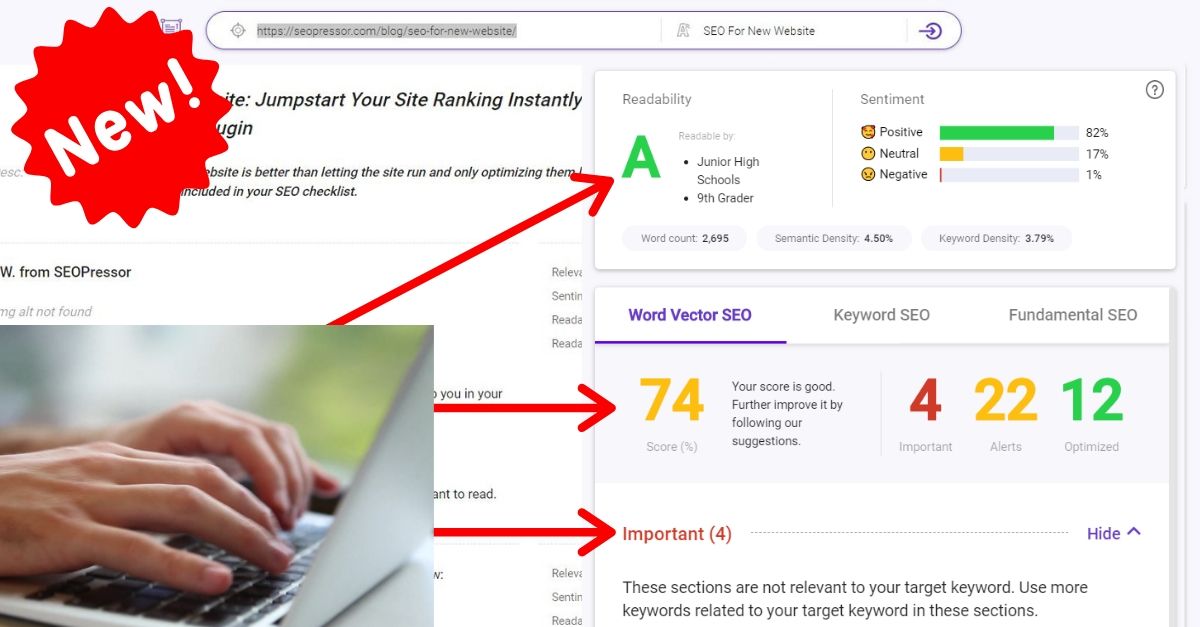

72
score %
SEO Score

Found us from search engine?
We rank high, you can too.
SEOPressor helps you to optimize your on-page SEO for higher & improved search ranking.
By vivian on September 9, 2015
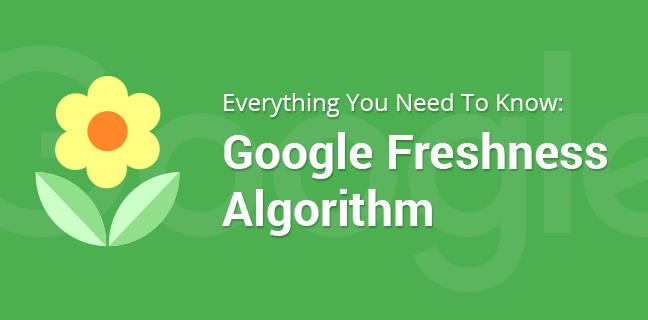
At this point, there’s a pretty good chance that you’re already pumping out good quality content on your blog as part of your online marketing strategy. You’re aware of how important good content is to not only generating leads but also to actually capturing the leads you generate; after all, Google rewards good content by providing your site with better search engine rankings, which helps provide more exposure to your brand.
However, the quality of your content – which the Google algorithm determines using various factors, from inbound links to social signals (such as Facebook likes and shares) – isn’t the only thing that the Google algorithm pays attention to. It also takes into account how fresh your content is.
[bof_display_offer id=8303]
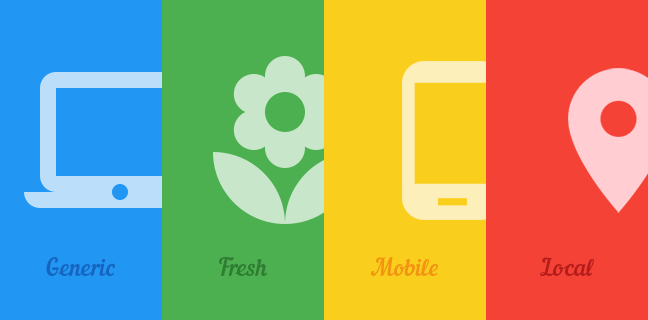
There are at least four main categories that the Google algorithm uses to determine the search engine ranking of a page – generic results, mobile results, local results and fresh results. These are all Google’s attempt to recognize different kind of search intent in order to answer them more accurately.
|
You can read more about the four search categories here: |
|---|
Freshness results is the time-sensitive dimension of the four search results. In order to describe what fresh results is, we need to first know about what type of search query that triggers fresh results. It is something that is known as Query Deserves Freshness.
Query Deserves Freshness (QDF) are queries that suddenly became very popular at one point of time compared to its normal activity. For example, for the keyword “Donald Trump”, the number of queries made for the keyword are relatively stable but spikes drastically when he announced his presidential campaign on June 2015.
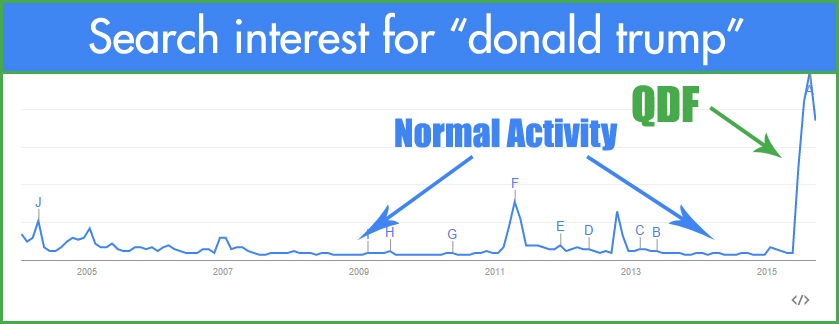
When the number of a certain queries made at a point of time dramatically increases, it signals a trending topic that requires fresh results.
When the spike in search volume occurs, Google will pick it up and know that something is happening with that specific keyword at that point in time. Users would want to know the latest progress in that particular topic, hence they deserve only the latest results.
To address this intent, Google applies freshness score and prioritizes websites with high freshness score (fresh results) compared to websites with low freshness score (stale results). This filter will be applied as long as the interest in the topic stays high.
At it’s core, fresh content is content that is up-to-date, newsworthy and relevant to current events. For example, a story of Donald Trump hosting The Apprentice is old news, which means it’s not fresh. When someone does a search for “Donald Trump” today, they’re probably no longer interested in knowing who Donald Trump fires this week on The Apprentice, but wanting to get updates on his current presidential campaign.
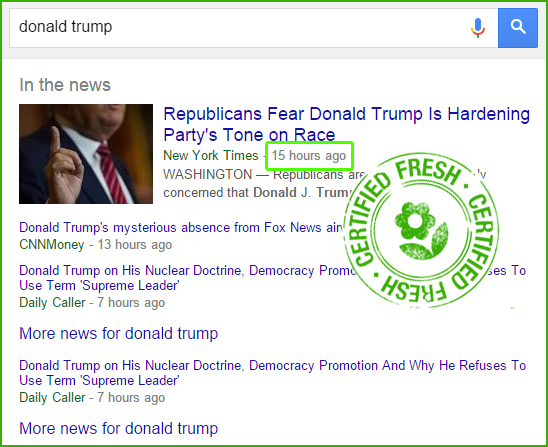
Fresh contents provides the latest information for trending queries.
The freshness score that Google applies to content helps to ensure that relevant content is ranked higher so that its results better meet their users’ search intent.
Creating content that’s fresh, such as time-sensitive content, is a great way to attract your readers’ interest and to tap into the search volume surge of trending topics. You’ll also have much less competition because a large bulk of stale contents will be pushed down, leaving only a handful of other websites with fresh results to compete with.
Another point worth mentioning, QDF makes quite a sizeable portion of the entire Google search – roughly 35% of all searches according to Google. That’s HUGE considering Google processes up to 3.5 billion searches daily!
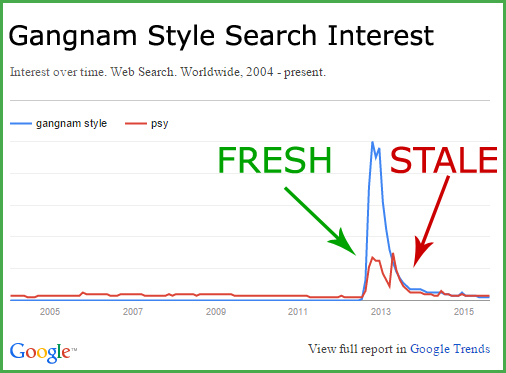
The downside of capitalizing on trending or viral topics is that they will no longer attract a lot traffic once the topic becomes stale.
Of course, creating fresh content also comes with a drawback – it will lose its value once the topic loses relevancy. For example, an article on Donald Trump’s presidential bid would be very relevant right now, but if he drops out of the race, is beaten by his democratic opponent or is elected president, that original content will no longer be relevant. For this reason, it is a very good idea to balance both evergreen and fresh contents rather than fully depending on just one type of content.

Photo by Christopher Craig
It’s not difficult to see why fresh content can help improve your ranking and how you will miss out by not paying attention to them. You don’t necessarily want all of your content to be fresh though – there should be a balance between “fresh” content and “evergreen” content, which is content that isn’t time sensitive and that will always remain relevant (such as “how to” articles).
But just by writing content that’s relevant and based on current events alone doesn’t guarantee you a high freshness score. Just like how Google generic search results works, writing a good content alone is not enough to get you ranked because there are other factors needed by Google in order to gauge the quality of your content and its relevancy to search queries such as the number of backlinks, domain authority as well as keyword usage.
So now you’re probably wondering, “then what do I have to do to get a high freshness score?” Well, let’s go over some of the factors that Google’s algorithm takes into consideration when giving you a freshness score:
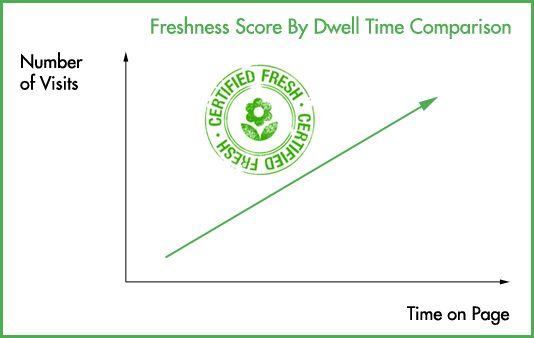
If users stay longer on your website than their previous visit, your website will be considered Fresh.
Great, so how do you keep visitors on your site for longer periods of time on their following visits? There are a couple of things that you can do – provide internal links with similar content that they can read, direct them to a public forum where they can discuss relevant subjects with other readers or encourage them to discuss their opinion on your comment page. The more incentives you provide to keep readers engaged, the better your dwell time will be.
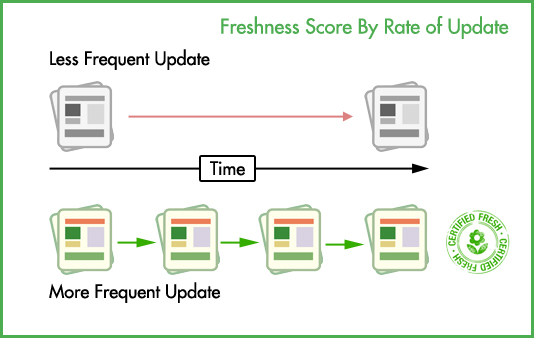
Updating your website more frequently will increase its Freshness score.
In addition to posting content on your blog regularly, you should also make sure you keep your business information updated as well. You’re really not trying if your physical business address has changed and you haven’t bothered to update it for the better part of the year.
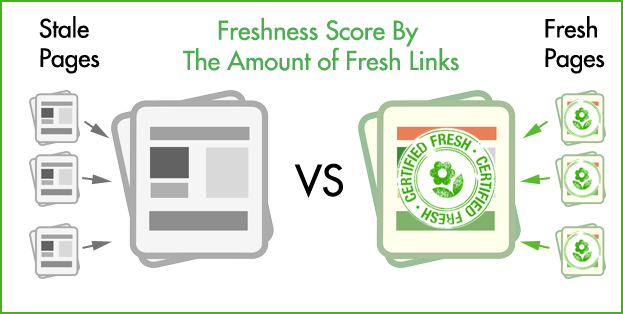
Links from other Fresh sources will increase your Freshness score as well.
If a website that hasn’t been updated in the last month has linked to your content, they’ll consider that link to be stale, which will hurt your freshness score instead of helping it. You want your inbound links to be coming from websites that have a consistently fresh ranking.
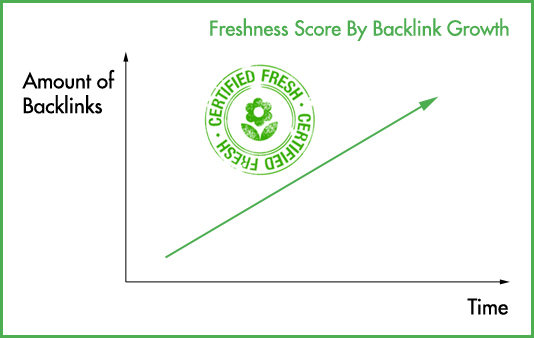
An increasing amount of backlinks signifies Fresh content, so focus more on distribution rather than just numbers.
A dwindling amount of backlinks signals a content getting stale, even if the initial amount is huge. Instead of focusing on just numbers, learn to distribute your link earning over a longer period of time in an increasing fashion – getting ten backlinks on the day a content is published, then thirty backlinks a week later is a much better indicator of its freshness than getting forty on the first day and none a week later.
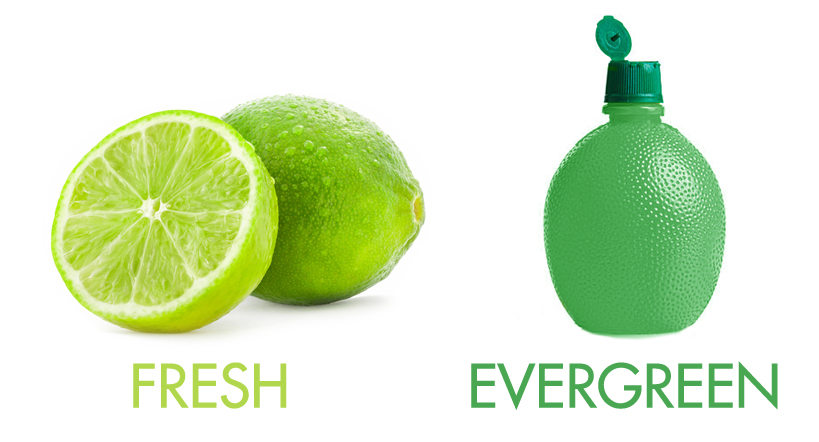
Guess which one spoils after a week?
Don’t let Google’s freshness ranking scare you into thinking that only fresh contents matters. Like we stated before, it’s good to have a balance between the two. While fresh contents are able to rack tons of traffic at its height, a single good evergreen content might still bring in more total traffic in the long run. Freshness is just one of the many factors that Google takes into account, after all.
Here’s how fresh and evergreen contents differs at a glance:
| Fresh | Evergreen |
|---|---|
| Less competition | Highly competitive |
| Highly focused traffic in a short amount of time | Steady flow of traffic overtime |
| Great deal of user interest | Doesn’t require a lot of research on trending topics |
| Loses value after topic is stale | Content is relevant all of the time |
| Need to constantly add new fresh contents in order to maintain traffic | Traffic adds up as more contents are added overtime |
| News, viral content, constantly updated subjects, regularly recurring events. | General information, how to’s, tutorial. |
As you can see, both type of contents have their pros and cons.
So what exactly is the conclusion that you’re supposed to draw from all of this? First of all, always consider the needs of your target audience when you are creating your content. If your audience is in search of newsworthy content, then you’ll want to focus on creating fresh content and pay attention to the factors that the Google algorithm uses to determine freshness.
But if your website is based more on providing informational content that can be described as evergreen content, then don’t trip all over yourself in an attempt to re-adjust your content strategy just to boost your freshness ranking. Basically, don’t fear the Google algorithm – think of them as different kind of tools that can useful in different kind of situations.
Updated: 1 July 2025


Save thousands of dollars (it’s 100x cheaper)

Zero risk of Google penalty (it’s Google-approved)

Boost your rankings (proven by case studies)
Rank High With This Link Strategy
Precise, Simplified, Fast Internal Linking.
